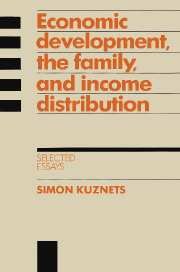Book contents
- Frontmatter
- Contents
- Preface by Louis Galambos and Robert Gallman
- Foreword by Richard A. Easterlin
- 1 Driving forces of economic growth: what can we learn from history?
- 2 A note on production structure and aggregate growth
- 3 The pattern of shift of labor force from agriculture, 1950–70
- 4 Modern economic growth and the less developed countries
- 5 Notes on demographic change
- 6 Recent population trends in less developed countries and implications for internal income inequality
- 7 Demographic aspects of the size distribution of income: an exploratory essay
- 8 Size and age structure of family households: exploratory comparisons
- 9 Size of households and income disparities
- 10 Distributions of households by size: differences and trends
- 11 Children and adults in the income distribution
- Afterword: Some notes on the scientific methods of Simon Kuznets by Robert William Fogel
- Bibliography of Simon Kuznets
- Index
3 - The pattern of shift of labor force from agriculture, 1950–70
Published online by Cambridge University Press: 12 November 2009
- Frontmatter
- Contents
- Preface by Louis Galambos and Robert Gallman
- Foreword by Richard A. Easterlin
- 1 Driving forces of economic growth: what can we learn from history?
- 2 A note on production structure and aggregate growth
- 3 The pattern of shift of labor force from agriculture, 1950–70
- 4 Modern economic growth and the less developed countries
- 5 Notes on demographic change
- 6 Recent population trends in less developed countries and implications for internal income inequality
- 7 Demographic aspects of the size distribution of income: an exploratory essay
- 8 Size and age structure of family households: exploratory comparisons
- 9 Size of households and income disparities
- 10 Distributions of households by size: differences and trends
- 11 Children and adults in the income distribution
- Afterword: Some notes on the scientific methods of Simon Kuznets by Robert William Fogel
- Bibliography of Simon Kuznets
- Index
Summary
Introduction
The comprehensive estimates by the International Labor Office of the industrial structure of the labor force distinguish three major sectors: agriculture, including forestry, fisheries and hunting; industry, including mining, manufacturing, construction, water, power and light utilities; and services, comprising all the other branches, ranging from transport, storage and communication to trade, finance, business services, personal services and government services.
Our interest here is in the pattern of the decline in the share of labor force in agriculture, a decline that was widespread from 1950 to 1970 – the two decades covered so far by the ILO estimates. Because the treatment of the female labor force varies widely among regions and countries, particularly for female workers in agriculture, we use the estimates for the share of the male labor force alone. While parallel calculations show that the patterns derived from the share of the total labor force in agriculture would differ only in detail, we thought it best to limit the statistical evidence here. It is not feasible to appraise critically the validity of the ILO estimates. We accept them as referring to approximate orders of magnitude, acceptance implying that the findings suggested by the estimates merit discussion and probing.
- Type
- Chapter
- Information
- Economic Development, the Family, and Income DistributionSelected Essays, pp. 47 - 67Publisher: Cambridge University PressPrint publication year: 1989
- 1
- Cited by



